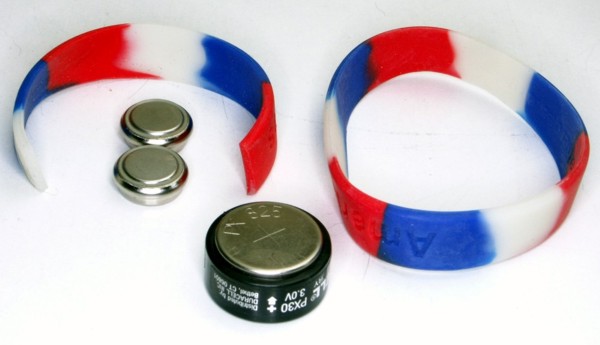
THE CREATIVE CORNER

If you are a do-it-yourselfer, you can try to find two (or more) batteries that will fit in your camera and provide the voltage that you need. If the batteries are not thick enough to make contact, you can add a spacer, made out of aluminum or steel that will get the batteries to make contact. After all, neccessity if the mother of invention!
You might also need to find/make gaskets to go around the battery -- to make it wider!
Here are some examples.
If you need a a PX-30 three volt battery for a Minolta QT (and some Kodak Instamatics), rummage around for one of those very popular (for some reason) silicone bracelets. These are ubiquitous, and if you have never seen one, you are in NOWHERESVILLE.

They are about 1/2" wide, very flexible, and easy to cut. All I did was cut a section out of one (on the left),
and wrapped it around two stacked 1.5 volt PX625 batteries. You'll need a piece 4-4.5" long -- depending on
the thickness of the bracelet. Start at 4.5", and cut off 1/4" sections until it fits in the battery
chamber -- and allows the battery door to close without any pressure. The width for the one I have is the perfect
size. You might need to make sure that the positive contact in the battery chamber (AWAY from the film chamber)
sticks out enough -- and clean, of course.
Another advantage of this wristband, is that it makes it super easy to remove the batteries. The end of the band
is easy to grip, and the batteries slide write out.
If you need a PX27 battery, look at old cameras and see if the seller with part with the dead batteries. Rather than have him throw them away, you can put them to use. I took an old PX27 battery, and with an X-acto knife, trimmed the turned over edge from the white plastic so as to expose the edges of the positive (+) plate. I gently lifted it out, and pulled the mercury cells from the white platic casing. Next, I broke the little welds holding the metal strips that held the cells and the plates together, and retained the end caps, disposing of the old cells --properly, I might add!. I then placed the two end caps together, with the convex sides out, and placed them into the plastic housing which at this point was simply a tube with a lip on the negative (-) end. I placed the two endplates so the smaller of the two convex sides was through the opening on the negative end, and was kept from going all the way through by the lip I kept on that end. I placed a SMALL drop of cyanocrylate glue inside the tube, where the endplates rested on the lip to hold them in place. I then took four 1.5volt 386 cells and placed them with the negative sides toward the endplates- the positive side of the last battery came to the edge of the plastic tube- I then put the whole assembly into my Minox C and so far it has worked like a charm. It resembles the adapter you can buy- I have seen prices up to nearly $30, so this is a rather inexpensive way to solve the battery problem with the Minox C! You have to remember, however, that the mercury cells you remove should be recycled- we have a hazardous waste disposal facility in our city, but if there is none where you are, many camera stores will accept the old cells, and send them in for disposal or recycling.
Last, but not least, PHOTOETHNOGRAPHY.COM has a long list of batteries for old photo gear -- and how to find & make alternatives.

To return to the main index for the Sub Club click here.
COPYRIGHT @ 1995-2025 by Joe McGloin. All Rights Reserved.